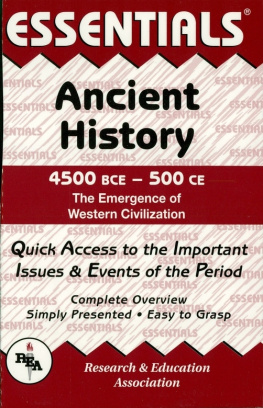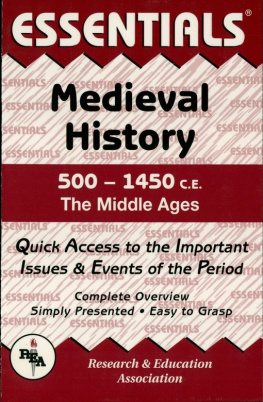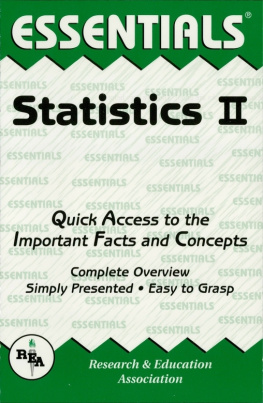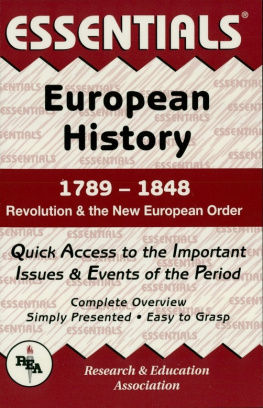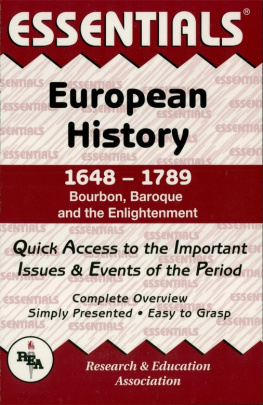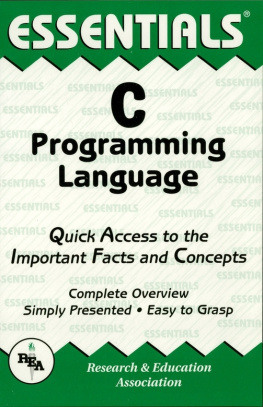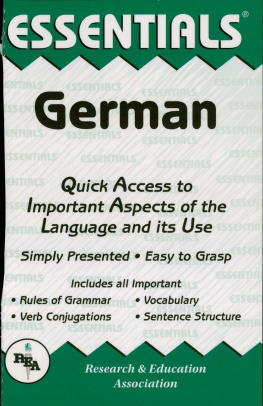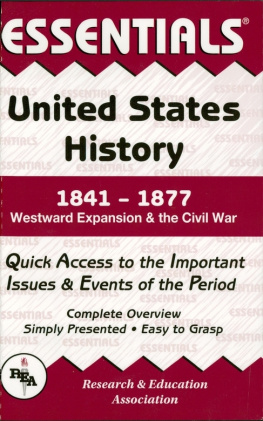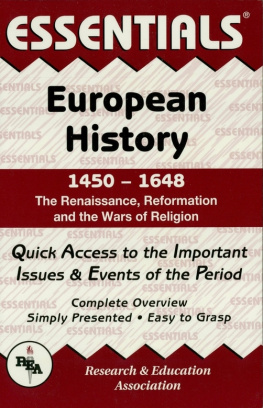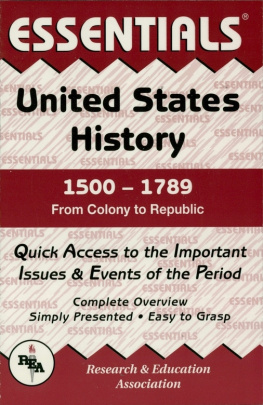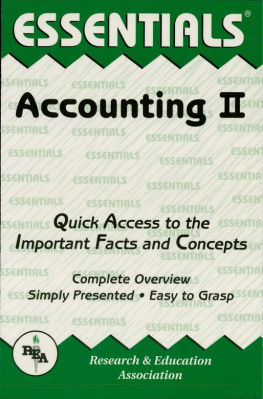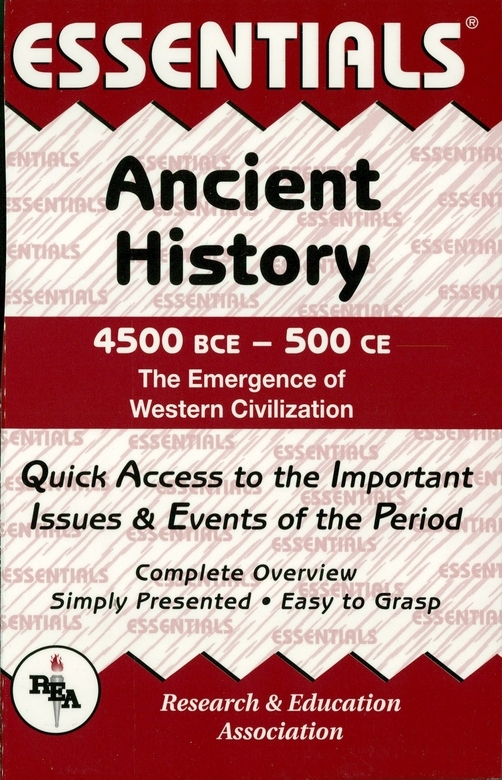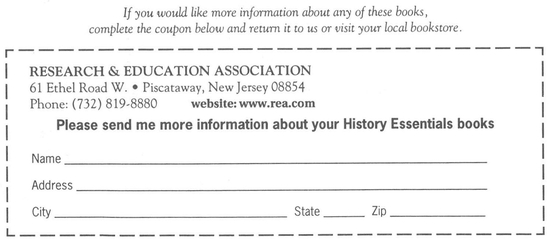About the Author
Gordon M. Patterson is an associate professor of history at Florida Institute of Technology, where he has taught since 1981. He was a lecturer at the University of Maryland from 1974 to 1981 and, before that, an instructor at the University of California at Los Angeles in 1973. A graduate of Northwestern University, he holds two graduate-level degrees from UCLA.
Dr. Patterson studied abroad in Vienna and at the Universitt Heidelberg, where he was a Fulbright Fellow in 197475. He has received three awards from the National Endowment for the Humanities for post-doctoral work at the University of Illinois, the Stanford Dante Institute, and Yale University. He is a member of the German Studies Association and the Dante Society of America. He was the 198990 chair of the Social Science section of the Florida Academy of Sciences and an assessing editor of the Journal of Mind and Behavior.
The ESSENTIALS of HISTORY
REAs Essentials of History series offers a new approach to the study of history that is different from what has been available previously. Compared with conventional history outlines, the Essentials of History offer far more detail, with fuller explanations and interpretations of historical events and developments. Compared with voluminous historical tomes and textbooks, the Essentials of History offer a far more concise, less ponderous overview of each of the periods they cover.
The Essentials of History provide quick access to needed information, and will serve as handy reference sources at all times. The Essentials of History are prepared with REAs customary concern for high professional quality and student needs.
| UNITED STATES HISTORY | EUROPEAN HISTORY |
| 1500 to 1789 From Colony to Republic | 1450 to 1648 The Renaissance, Reformation & Wars of Religion |
| 1789 to 1841 The Developing Nation |
| 1841 to 1877 Westward Expansion & the Civil War | 1648 to 1789 Bourbon, Baroque & the Enlightenment |
| 1877 to 1912 Industrialism, Foreign Expansion & the Progressive Era | 1789 to 1848 Revolution & the New European Order |
| 1912 to 1941 World War I, the Depression & the New Deal | 1848 to 1914 Realism & Materialism 1914 to 1935 World War I & Europe in Crisis |
| America since 1941: Emergence as a World Power | Europe since 1935: From World War II to the Demise of Communism |
| WORLD HISTORY | CANADIAN HISTORY |
| Ancient History (4500 BC to AD 500) | Pre-Colonization to 1867 |
| The Emergence of Western Civilization | The Beginning of a Nation |
| Medieval History (AD 500 to 1450) | 1867 to Present |
| The Middle Ages | The Post-Confederate Nation |
These Little Books have rescued lots of grades and more!
(a sample of the hundreds of letters REA receives each year)
Your Essentials books are great! They are very helpful, and have upped my grade in every class. Thank you for such a great product.
Student, Seattle, WA
I recently purchased six titles from your history Essentials series and I find them to be excellent.
Student, Dublin, Ireland
Thank you for volumes I & II of The Essentials of Statistics. I am very pleased with these two little booklets.
Student, Portland, OR
The Essentials book always comes to the rescue.
Student, Norwood, MA
Ive had the pleasure of using your Essentials of Physics study guide books, and have found them to be very helpful.
Student, Minneapolis, MN
CHAPTER 1
THE EARLIEST BEGINNINGS OF CIVILIZATION
1.1 HISTORY AND PREHISTORY
1.1.1 Definition of History
The word history comes from the Greek historia, which means to inquire or to research. The content of history consists of all past human actions (thought and deed). Historians are responsible for discovering facts or evidence about past actions and interpreting or evaluating the meaning of these facts as they narrate the story of the past.
1.1.2 Period of Ancient History
Ancient history covers the period from the first appearance of human beings up to the middle of the sixth century of the Common Era (550 C.E.).
1.1.3 Difference Between History and Prehistory
Prehistory refers to the period prior to the discovery of writing around 3500 B.C.E. (Before the Common Era) in the ancient Near East. Before the discovery of writing, historians rely on the techniques of archaeologists and anthropologists in constructing their descriptions of ancient life.
1.2 THE APPEARANCE OF MAN
1.2.1 Human Evolution
Scientists estimate that the Earth is 4 to 6 billion years old. A controversy rages among paleontologists (scholars who study fossils and ancient forms of life) as to the date of the evolutionary split between ape-like (pongids) and man-like (hominid) creatures. A few scholars maintain that an animal called Ramapithecus, which lived 14 million years ago, is mans most distant ancestor. Most paleontologists, however, believe that the evolutionary split which led to the appearance of Homo sapiens (thinking man) occurred 4 million years ago. Fossil remains from East Africa of the earliest known hominid, Australopithecus afarensis, support this conclusion. Though this creature did not belong to the Homo family, one branch of its descendents developed a larger brain, a slender body, and smaller teeth, and is therefore considered the direct ancestor of modern humans.
1.2.2 The First Humans
In 1974, Donald Johanson and Maurice Taieb discovered in Ethiopia a partial skeleton of a three-foot-tall female member of the species Australopithecus afarensis. Known popularly as Lucy, she was very apelike in build and estimated to be just over 3 million years old. Emerging perhaps 2.5 million years ago was Homo habilis, who walked erect, had a larger brain than the apes, and fashioned primitive tools. In 1960, the first early member of this genus was identified by Louis Leakey at Olduvai Gorge in Tanzania. Homo habilis is the likely immediate ancestor to Homo erectus (who appeared about 1.6 million years ago), which is to say, the first in a line that leads to us. It was Richard Leakey who, in 1984, found a nearly intact skeleton of Homo erectus that was more than 1.5 million years old; the fossil was dubbed Turkana Boy (after Lake Turkana in northern Kenya). Members of this species were taller than their predecessors and possessed a brain sufficiently developed to allow them to make stone tools and harness fire.
1.2.3 From Nature to History
Early human development was marked by four periods of glaciation (Ice Ages) that occurred intermittently from 3 million B.C.E. to 40,000 B.C.E. Humans ( Homo sapiens ) appeared near the beginning of the last Ice Age (80,000-70,000 B.C.E.). Homo sapiens , sometimes called Cro-Magnon Man (after a cave where fossil remains were discovered in France), shared the world with other populations. Neanderthal Man (whose remains were discovered in the Neander River valley in Germany) was Cro-Magnon Mans chief competitor. Neanderthals lived in camps, used fire, and ritualistically buried their dead. Cro-Magnon Man triumphed over his rivals by 40,000 B.C.E. (end of last Ice Age).

